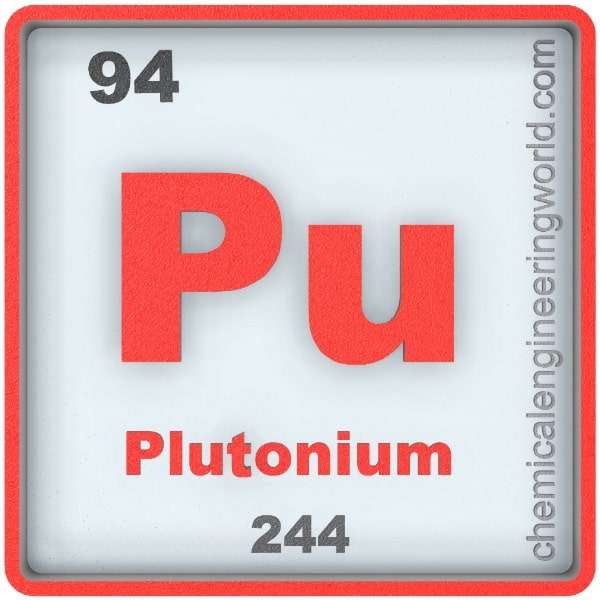Plutonium Element Properties and Information

Plutonium Element Properties and Information
Plutonium is 94th element on the periodic table. Elements are arranged in the periodic table on the basis of the atomic number. Atomic number is the number of protons in the nucleus of the atom. Plutonium has an atomic number of 94. It is located in the Group ‘Actinides’ and Period 7 of the periodic table of elements. It is denoted by the symbol ‘Pu’. The name is derived from the planet, Pluto.
Glenn Seaborg, Arthur Wahl, Joseph Kennedy, and Edwin McMillan are credited as discoverers of plutonium after they bombarded uranium-238 with alpha particles. Plutonium is found in nature only in trace amounts. It is obtained as a radioactive decay product. Minute quantities of plutonium are also found in human body.
Physical Properties
- Plutonium is an actinide metal which has a bright silvery appearance.
- The atomic mass of plutonium is (244).
- The melting point of plutonium is 641°C.
- The boiling point of plutonium is 3232°C.
- The density of plutonium is 19840 in S.I. units at 20°C.
- The electrical resistance of plutonium is very high at room temperature; and the resistance increases as the temperature decreases.
- Plutonium has 7 allotropic forms.
- Nearly 20 radioactive isotopes of plutonium have been characterised so far.
Chemical Properties
- Plutonium tarnishes when exposed to air.
- Plutonium compounds commonly display 4 oxidation states; +4, +3, +2, +1 and 1 rare oxidation state; -3.
- Plutonium is capable of forming alloys with most common metals.
Methods of Production
Nucleosynthesis: Plutonium-238 and plutonium-239 are the most widely synthesized isotopes of plutonium. Plutonium-238 is synthesised by bombarding uranium-238 with deuterons. And for plutonium-239; Beta decay of uranium-238 forms neptunium-239 which further undergoes beta decay to form plutonium-239.
Relevance in Chemical & Related Industries
No relevant use in chemical or process industries.
Relevance in Other Industries
- MOX fuel: The spent nuclear fuel from light water reactor contains variety of plutonium isotopes. It is used as a mixed oxide (MOX) nuclear fuel.
- Power generation: Plutonium is used in radioisotope thermoelectric generators because 1 kg of plutonium isotope generates 570 watts of heat.
Health effects on Exposure
Inhalation & Ingestion: The alpha radiation of plutonium does not penetrate the skin but if it is inhaled then it can cause cancer in lung and if it is ingested then it can cause cancer in digestive system.
Effects on Surroundings
- Accumulation: Plutonium tends to accumulate in soils during nuclear weapons testing.
References:
https://en.wikipedia.org/wiki/Plutonium
































